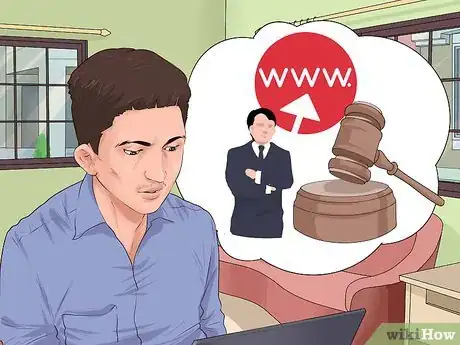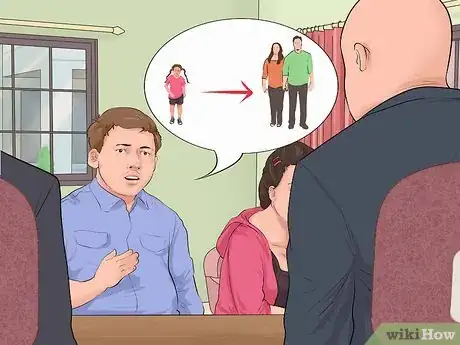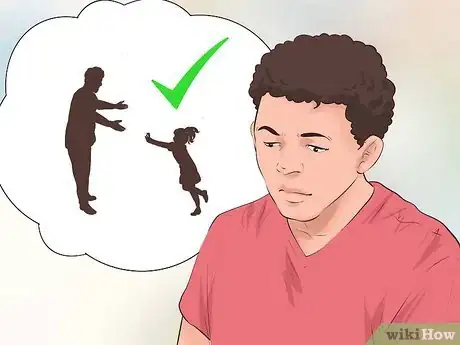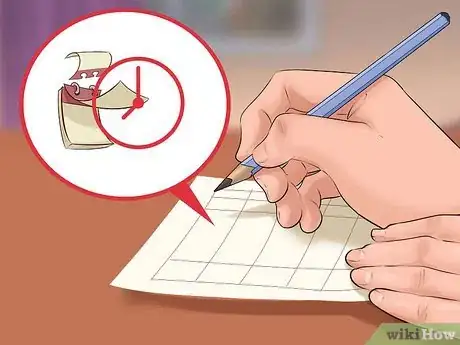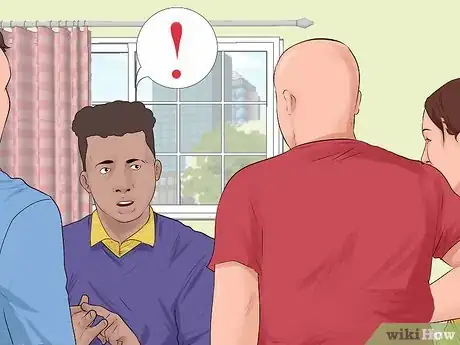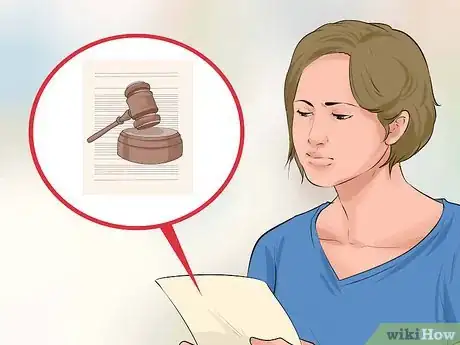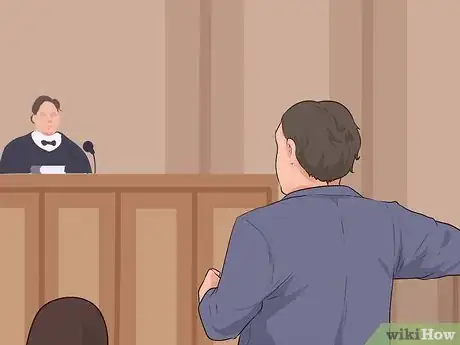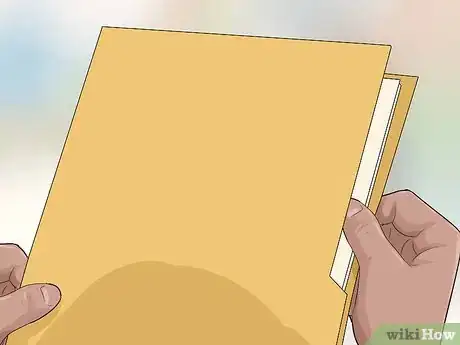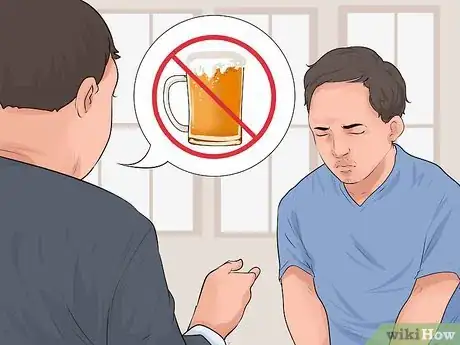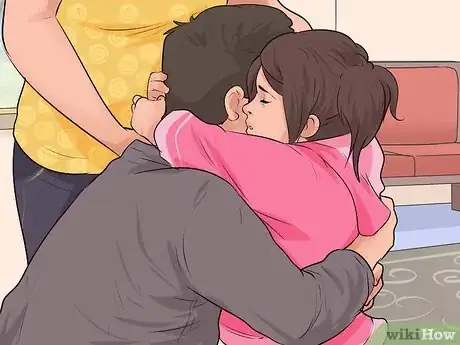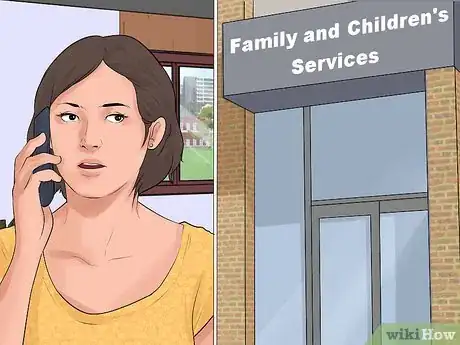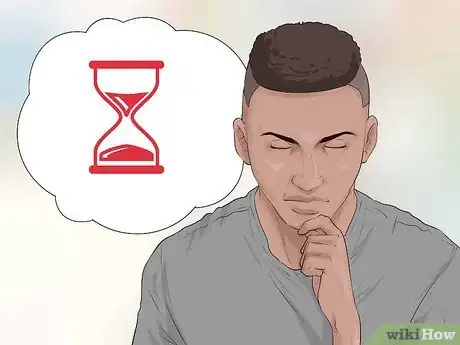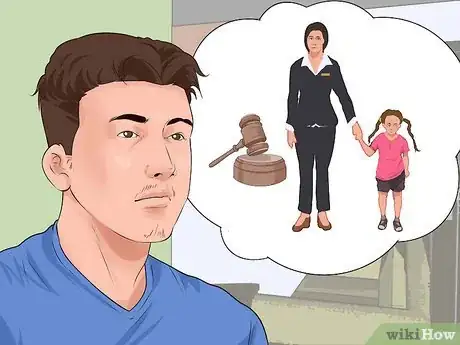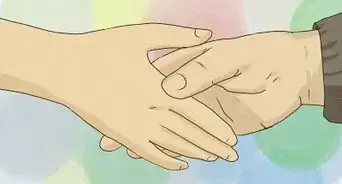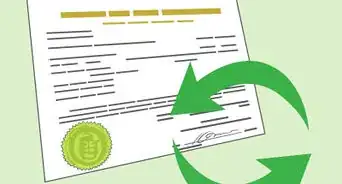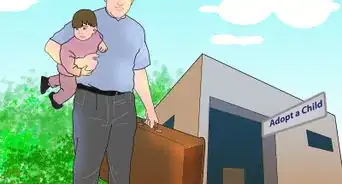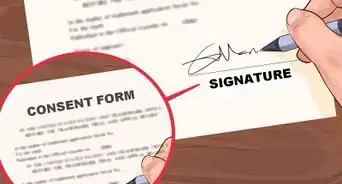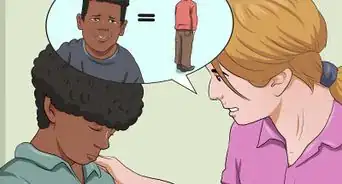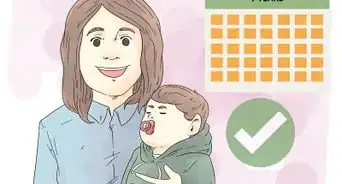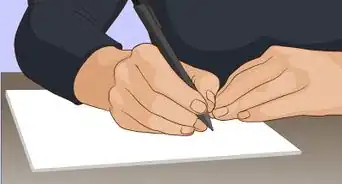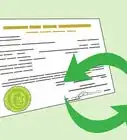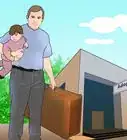This article was co-authored by Clinton M. Sandvick, JD, PhD. Clinton M. Sandvick worked as a civil litigator in California for over 7 years. He received his JD from the University of Wisconsin-Madison in 1998 and his PhD in American History from the University of Oregon in 2013.
This article has been viewed 114,177 times.
When an abuse or neglect report has been filed by someone regarding you and your child, you may be feeling upset and concerned. If a report has been filed and verified, there may be a possibility that your child will be taken away from you and placed in another home. While this sort of placement is usually not permanent, it is important to understand how and why it happens. In addition, if your child has been taken away from you, it is imperative you know how to have them reunified with you.
Steps
Knowing Your Rights
-
1Find an attorney. If your child has been taken out of your custody, you should seriously consider hiring a reputable family law attorney. Family law attorneys can specialize in many different disciplines (e.g., divorce, adoption, custody) so be sure you find one that specializes in juvenile court processes and custody issues. To find a reputable attorney, call your local bar association or visit their website. State and town bar associations often have attorney referral services for your convenience. You can also talk to friends and family to see if they have any recommendations.
- If you cannot afford an attorney, one will be appointed to you during your first hearing, which will be the detention hearing.
-
2Request that your child be placed in the care of a relative. At your first meeting with the social worker assigned to your case, which will be the Team Decision-making Meeting (TDM), you will have a chance to ask that your child be placed in the custody of a relative. When you attend your TDM, you should bring any family member you are thinking about having take responsibility of your child. Regardless of your efforts, the social worker will also contact relatives to inquire about having the child placed with them.
- In order to have your child placed with a relative, that relative must pass a background check and must have a place for the child to sleep. CPS will walk through the relative's home in order to ensure the home's safety.
- Do not worry if your relative is financially unable to care for your child. In this event, your relatives would receive a monthly stipend to help care for your child.[1]
Advertisement -
3Ask CPS about the nature of the allegations against you. When your child is taken from you, you will have the right to ask why. When you do so, ask the social worker about the nature of the allegations against you and what has been alleged. In addition, you can ask about how the CPS process will be conducted and what you can expect. Finally, you can always ask CPS what will happen as a result of any court hearings and processes.[2]
-
4Know about your right to visit your child. If your child has been taken from you, know that you have the right to visit them. In order to do so, you must talk with CPS and discuss how this can be arranged. In general, you will have the right to visit your child within five days of them be taken from you. This first visitation will likely be supervised. After that first visit, talk with the social worker assigned to your case about working out a schedule of when you can visit with your child in the future.
- If you disagree with the social worker's decisions regarding visitation, you have the right to appeal their decision to a court.[3]
-
5Consider a possible timeline. When your child is taken out of your custody, the social worker must complete certain tasks within a specific timeline. This ensures your child is not taken away from your for longer than necessary and that you have the ability to be heard in court. In general, your case will proceed as follows:
- On day one, your child will be removed from your care and the social worker assigned to your case will have 48 hours to gather facts and prepare a petition for a juvenile court.
- On day two, you will be notified about the date and time of your first hearing, which is called a detention hearing.
- On day three, the social worker will file their petition, which explains to the court why your child has been removed from your custody.
- On day four (or within 72 hours of your child being removed), your detention hearing will take place in order to determine where your child will stay. You will be assigned an attorney at this hearing if you have not already hired one.[4]
-
1Gather supporters. Before your Team Decision-Making Meeting (TDM), gather as many supporters as you can and ask them to join you. They could be neighbors, family members, teachers, doctors, etc.. They will be able to talk to the social worker and convince them of your fitness to maintain custody of your child.
- In addition, be prepared to discuss why it would be safe for your child to return home. For example, if your child was taken from you due to neglect, be prepared to show the social worker that you have a plan in place to never neglect your child again.
-
2Take part in a TDM. As soon as is reasonably possible after your child has been removed from your custody, you will be notified of a TDM. During this meeting, you and any supporters you have will meet with the social worker and discuss whether a safety plan can be developed so that your child can be returned to you. A safety plan will address all of the safety concerns that caused your child to be taken away from you and will dictate how those concerns will be alleviated.
- If all safety concerns can be adequately addressed, your child may be returned to you.
- However, if not all concerns can be alleviated, your child will remain in out-of-home care and a court hearing will be scheduled.[5]
-
3Watch for a notification about your child's detention hearing. At your detention hearing, a judge will get an impression of the case and will determine where your child will be placed. Before the hearing begins, you will be given an opportunity to read the petition the social worker filed and you will have an an opportunity to ask questions about it. You need to make sure you attend this hearing because vital decisions will be made about your child and their well-being. If you attend, you can help make these decisions and you will show the court that you care about your child.
- If you do not attend, the court will move forward without you and you will be sent a letter notifying you of the next hearing.[6]
-
4Attend a jurisdictional hearing. About two weeks after your detention hearing, you will have the opportunity to attend a jurisdictional hearing. At this hearing, you will admit or deny all of the statements in the petition the social worker filed with the court. The court will then make a determination as to the truth of the petition and your statements about it. When you attend this hearing, come prepared and be sure you have read and understand the petition. If possible, bring with you evidence of your ability to care for your child.
- If the judge agrees with the petition, the court will schedule a dispositional hearing, which may take place at the same time as the jurisdictional hearing or at a different time.
- If the judge agrees with you and finds the petition to be untruthful, the case may be dismissed and your child will be returned to you.[7]
-
5Go to the dispositional hearing. At this final hearing, the court will listen to testimony from both sides and will consider evidence that either party presents. If the court determines that your child should remain out of your custody, the court will make orders about when and how you can visit your child and what services you will be required to complete. If the court determines that your child can be returned to you, this will happen.
- As a part of the court's order, you will take part in creating and following a "case plan." A case plan outlines the services you will need to take part in, the steps you will need to follow, and timelines that will be required to be followed in order to have your child returned to you.[8]
-
6Prepare evidence of your ability to parent. When you attend the dispositional hearing, be sure you prepare adequately. If you have people that can testify on your behalf, bring them. If you have evidence of your ability to parent, bring it.
- For example, if your child was taken from your custody due to unsafe living conditions, bring a new lease that shows you have moved in to a more suitable home. If your child was taken from you because you were abusing drugs, bring recent statements from rehabilitation centers stating that you are working to fix your problem.
Reunifying Your Family
-
1Take part in any dependency review hearings. If your child continues to be out of your custody for any extended period of time, you will need to take part in dependency review hearings every six months, if not sooner. During these hearings, the court will review a report from the social worker about your progress with your case plan. At these hearings, the court will determine whether to continue or terminate out-of-home services. If you have followed your case plan and are making good progress, you may have your child returned to you. If you still have work to do, your child may remain out of your custody until you make more progress.[9]
- When you attend these reviews, be prepared to answer questions about your case plan and your ability to follow it. If it would help, see if you can bring in people to corroborate and back up your claims. Consider keeping a checklist of tasks you have completed and how those tasks relate to the requirements in you case plan. See if you can check off all requirements before your first review hearing. If you can do so, your chances of regaining custody of your child will increase greatly.
-
2Continue making progress. If your child is not returned to you after your first dependency review hearing, ask the court and the social worker what you can do to make more progress before the next review. Everyone involved usually wants your child to be returned to you, so they should be willing to give you their advice. Once you receive their advice, take it seriously and do what they say.
- For example, if your child was taken out of your custody due to alcohol or drug abuse, the court may ask you (or require you) to take part in rehabilitation sessions. If this is the case, do what they say and get better. Your child will only be returned to you when the court is confident in your ability to parent.
-
3Have your child returned to you. Over time, as you take part in all required dependency review hearings and complete all requirements under your case plan, the court will make the decision to return your child to you. When this happens, your case will be closed and you will be reunified with your child.[10]
Understanding the Process
-
1Get contacted after a report has been evaluated. When an individual suspects you have been abusing or neglecting your child, they can file a report with your state's Child Protective Services (CPS) (also called Family and Children's Services, Health and Human Services, or something similar). Most often these reports are filed by other parents, neighbors, teachers, or police officers.[11] The most common reasons these individuals file a report include alcohol or drug abuse, physical abuse or neglect, or other safety issues in your home.[12] In general, once a report has been evaluated by CPS, you can expect one of the following responses from a social worker:
- A community response. When the emergency response social worker find the report to be unfounded or inconclusive, the report will be closed. However, the social worker may contact you to discuss the report and may refer you to community-based organizations that may be able to help you stay out of trouble in the future.
- A differential response. If the social worker assigned to your report finds it to be credible but finds no immediate threat to the health or safety of your child, the report will be closed but the social worker will contact you about the report. The social worker will likely require you to contact and meet with certain organizations in order to ensure the health and safety of your child.
- A traditional CPS response. If the social worker finds an immediate threat to the health and safety of your child, a welfare case will be opened and you will be notified.[13]
-
2Wait to hear about the outcome of your welfare case. When a welfare case is opened, it does not automatically mean your child will be removed from your custody. In general, a welfare case can have one of three outcomes:
- First, if the social worker finds high-risk factors (for example, evidence of abuse or neglect) but also finds that any safety threats have been reduced, your child will be allowed to stay with you. However, you and the social worker will have to create a "safety plan," which is a number of things you will need to do in order to keep your child with you.
- Second, the social worker can get the juvenile court system involved. If this happens, the court will be involved in your activities until you can resolve the issues that led to this response.
- Third, if the social worker finds immediate safety concerns, they can remove your child from your custody and place them in a safe environment.[14]
-
3Understand who can remove your child from your custody. When a social worker determines your child needs to be removed from your custody for safety reasons, that social worker will come to your home and talk with you and your child. With your permission, the social worker will remove the child from the home. If you do not give the social worker permission to remove your child, the social worker may employ the help of law enforcement or may seek to obtain a warrant from a juvenile court. If this happens, your child may be forcibly removed from your home.[15]
-
4Know what happens if your child is removed. When your child is removed from your home, they will be taken to a CPS office and evaluated to ensure they are healthy and safe. Afterwards, CPS will make a determination about where the child will be placed. Usually, a child will be placed:
- In the home of another parent;
- In the home of a relative; or
- In foster care.[16]
References
- ↑ http://www.sfhsa.org/asset/ReportsDataResources/FCSHandbookforParents.pdf
- ↑ http://www.sfhsa.org/asset/ReportsDataResources/FCSHandbookforParents.pdf
- ↑ http://www.sfhsa.org/asset/ReportsDataResources/FCSHandbookforParents.pdf
- ↑ http://www.sfhsa.org/asset/ReportsDataResources/FCSHandbookforParents.pdf
- ↑ http://www.sfhsa.org/asset/ReportsDataResources/FCSHandbookforParents.pdf
- ↑ http://www.sfhsa.org/asset/ReportsDataResources/FCSHandbookforParents.pdf
- ↑ http://www.sfhsa.org/asset/ReportsDataResources/FCSHandbookforParents.pdf
- ↑ http://www.sfhsa.org/asset/ReportsDataResources/FCSHandbookforParents.pdf
- ↑ http://www.sfhsa.org/asset/ReportsDataResources/FCSHandbookforParents.pdf
- ↑ http://www.sfhsa.org/asset/ReportsDataResources/FCSHandbookforParents.pdf
- ↑ https://www.lawyers.com/legal-info/family-law/child-abuse-and-neglect/working-with-child-services-to-get-your-child-back.html
- ↑ http://www.attorneys.com/child-custody/steps-for-getting-back-custody/
- ↑ http://www.sfhsa.org/asset/ReportsDataResources/FCSHandbookforParents.pdf
- ↑ http://www.sfhsa.org/asset/ReportsDataResources/FCSHandbookforParents.pdf
- ↑ http://www.sfhsa.org/asset/ReportsDataResources/FCSHandbookforParents.pdf
- ↑ http://www.sfhsa.org/asset/ReportsDataResources/FCSHandbookforParents.pdf
About This Article
Losing custody of your child can be really tough, but with the right legal support and preparation, you’ll put yourself in the best position to get them back. If you can afford one, get an attorney who specialises in juvenile court processes and custody issues. If not, you’ll be appointed an attorney during your first hearing. Gather all the evidence you have that your child will be safe with you. For example, if your child was taken away due to drug issues, get a note from rehab to show that you’re clean. You can also get supporters, such as neighbors, family members, teachers, and doctors, who can help convince your social worker of your ability to look after your child. Attend your jurisdictional hearing and dispositional hearing where you can present your case to the judge. For more advice from our Legal co-author, including how to see your kids before you get custody back, read on.
